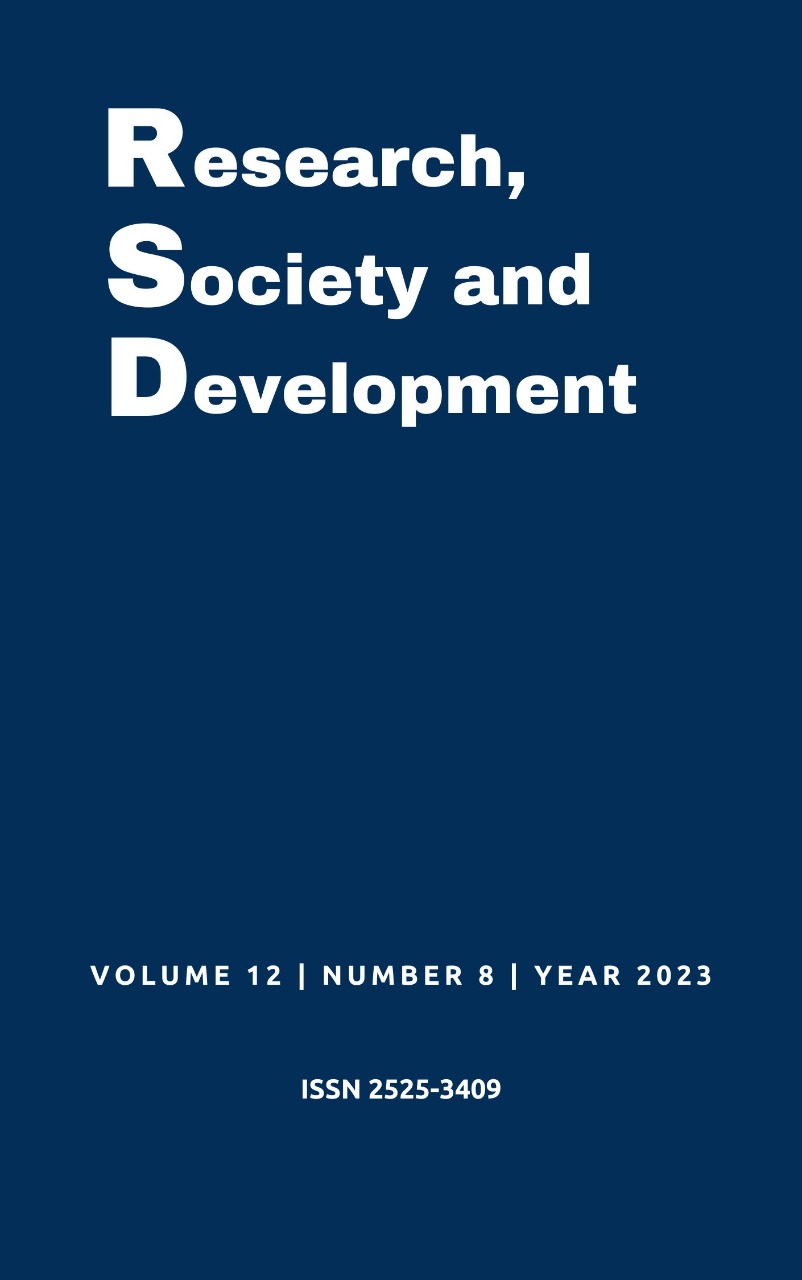Relationship between Deciduous Molar Hypomineralization (HSMD) and Molar-Incisor Hypomineralization(HMI): A cross-sectional study
DOI:
https://doi.org/10.33448/rsd-v12i8.42821Keywords:
Hypomineralization molars, Molar-incisor hypomineralization, Children.Abstract
Considering that the development of deciduous second molars and first permanent molars and incisors begins at approximately the same time, the presence of hypomineralization in deciduous second molars (HSMD) should serve as a warning for the involvement of first permanent molars by molar-incisor hypomineralization (MIH). The aim of this study was to assess the prevalence of HSMD and MIH in children, and the association between both. A cross-sectional study was carried out with children treated at the Pediatric Dentistry Clinic at Ceuma University, in São Luís, Maranhão. The HMI was evaluated according to the criteria of the European Association of Pediatric Dentistry (EAPD) (presence/absence and degree of severity: mild and severe). The same HSMD evaluation criteria were adopted. Descriptive statistical analysis (frequency of HSMD and HMI; mean number of teeth injured by HSMD and HMI; severity of lesions: mild or severe), bivariate (comparison between sexes and age regarding the frequency of HSMD and HMI and the association between HSMD and hypomineralization of the first permanent molar - HPMP) and antibodies (Spearman) were performed, at a significance level of 5%. Forty children were examined, 25 males and 24 females. The prevalence of HSMD was 38.8% and MIH was 46.9%. As for the severity of injuries, the severe degree was more frequent for both HSMD and HMI (10/20.4% and 12/24.5%, respectively). There was a positive change between the factor under study (HSMD) and HPMP (r=0.513; p=0.001). Based on the findings, it was concluded that HSMD is related to MIH, which demonstrates the importance of professional monitoring of teeth likely to be involved by the defect from the moment of eruption in the oral cavity.
References
Andrade, N. S. et al. (2017). Molar incisor hypomineralization in HIV-infected children and adolescents. Spec. Care Dentist., Chicago, 37(1), 28-37.
Costa K. N. B., Silva M. S., Vieira C. L., & Ferreira M. C. M. (2021). Hipomineralização de dentes decíduos relacionada ao período de mineralização dental: relato de caso. RSBO. 18(2), 375-81.
Costa-Silva, C. M., Paula, J. S. d., Ambrosano, G. M. B. & Mialhe, F. L. (2013). Influence of deciduous molar hypomineralization on the development of molar-incisor hypomineralizarion. Braz J Oral Sci. 12, 335–338. 2013.
Elfrink M. E. C., Ten Cate J. M., Jaddoe V. W. V., Hofman A., Moll H. A., & Veerkamp J. S. J. (2012). Deciduous molar hypomineralization and molar incisor hypomineralization. J Dent Res., 91(6), 551-5. 2012.
Farias L., Laureano I. C. C, Alencar C. R. B., & Cavalcanti A. L., (2018). Hipomineralização molar-incisivo: etiologia, características clínicas e tratamento. Rev. Ciênc. Méd. Biol., Salvador, 17(2), 211-219.
Garcia-Margarit, M., Catala-Pizarro, M., Montiel-Company, J. M. & Almerich-Silla, J. M. (2014). Epidemiologic study of molar-incisor hypomineralization in 8-year-old Spanish children. Int J Paediatr Dent. 24, 14–22.
Lustosa, P. A., Ferreira, R. B., & Vieira, L. D. S. (2020). Hipomineralização molar incisivo: revisão de literatura. R Odontol Planalt Cent.
Mejare, I., Bergman, E. & Grindefjord, M. (2005). Hypomineralized molars and incisors of unknown origin: treatment outcome at age 18 years. Int J Paediatr Dent. 15, 20–28.
Mittal, N. & Sharma, B. B. (2015). Hypomineralised second primary molars: prevalence, defect characteristics and possible association with Molar Incisor Hypomineralisation in Indian children. Eur Arch Paediatr Dent. 16, 441–447.
Resende, P. F, & Favretto, C. O. (2019). Desafios clínicos no tratamento de hipomineralização molar incisivo. Journal of Oral Investigations, Passo Fundo, 8(2), 73-83.
Salem, K., Aziz, D., & AsadiI, M. (2016). Prevalence and predictors of Molar Incisor Hypomineralization (MIH) among rural children in Northern Iran. Iran. J. Public. Health, Tihrān, 45(11), 1528-1530, nov. 2016.
Silva, A. R. S. F., Moraes, G. M., Guedes, P. F., Koga, R.S., & Carlos, A. M. P., (2020). Tratamento de hipomineralização molar-incisvo em odontopediatria: revisão de literatura. Brazilian Journal of health Review. Curitiba, 3(6), 16789-16801.
Silva-Júnior, I. F., Nicoloso, G. F., & Mariath, A. A. S. (2015). Tratamento de molares afetados pela hipomineralização molar-incisivo: uma revisão ilustrada da literatura. 2015. 20f. Trabalho de Conclusão de Curso (Especialização em Odontopediatria) – Universidade Federal, Rio Grande do Sul, 2015.
Solanki, P. H., Mathur, A., Kamath, A., & Patil, V., (2020). Influence of Deciduous Molar Hypomineralization on Molar Incisor Hypomineralization – A Systematic Review. Indian Journal of Public Health Research & Development, 11(6), 1155.
Temilola, O. D., Folayan, M. O. & Oyedele, T. (2015). The prevalence and pattern of deciduous molar hypomineralization and molar-incisor hypomineralization in children from a suburban population in Nigeria. BMC Oral Health. 30(15), 73.
Downloads
Published
Issue
Section
License
Copyright (c) 2023 Douglas Barros Ferreira; Antonio Fabrício Alves Ferreira; Maria Fernanda Sousa; Sávio José da Silva Brito; Lucas Vinícyus Lima Maia Miranda

This work is licensed under a Creative Commons Attribution 4.0 International License.
Authors who publish with this journal agree to the following terms:
1) Authors retain copyright and grant the journal right of first publication with the work simultaneously licensed under a Creative Commons Attribution License that allows others to share the work with an acknowledgement of the work's authorship and initial publication in this journal.
2) Authors are able to enter into separate, additional contractual arrangements for the non-exclusive distribution of the journal's published version of the work (e.g., post it to an institutional repository or publish it in a book), with an acknowledgement of its initial publication in this journal.
3) Authors are permitted and encouraged to post their work online (e.g., in institutional repositories or on their website) prior to and during the submission process, as it can lead to productive exchanges, as well as earlier and greater citation of published work.


